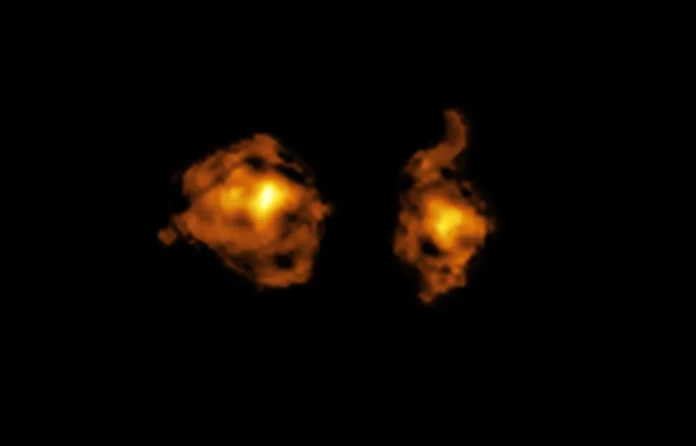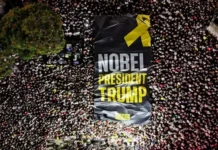
For the first time, astronomers have witnessed what they describe as a “cosmic joust”, a dramatic encounter between two galaxies locked in a high-speed celestial battle 11 billion light-years away.
The extraordinary phenomenon, documented over nearly four years using Chile’s Atacama Large Millimeter/submillimeter Array (ALMA) and the European Southern Observatory’s Very Large Telescope (VLT), captures a rare moment in the universe’s early history when galaxy collisions were more frequent.
In this cosmic confrontation, the galaxies are seen hurtling toward each other at a staggering speed of 1.8 million kilometers per hour. One galaxy, armed with an intensely radiant quasar at its core, bombards its neighbor with powerful ultraviolet radiation. These energetic blasts disperse the molecular gas clouds in the opposing galaxy — the raw materials needed for star formation — effectively stalling its ability to create new stars.
An artist’s illustration of the dueling galaxies shows how radiation from the quasar reaches the other galaxy from a distance of thousands of light-years. VIDEO/COURTESY
“That’s why we call it a ‘cosmic joust,’” explained Pasquier Noterdaeme, a researcher from the Paris Institute of Astrophysics and co-lead author of the study published in Nature. “The quasar’s radiation acts like a weapon, disrupting its opponent’s structure from across space.”
The quasar, powered by a supermassive black hole, emits energy a thousand times stronger than the Milky Way’s radiation. Its impact is so forceful that it ionizes and breaks apart hydrogen molecules in nearby star-forming regions, weakening its rival galaxy’s star-making capacity. Researchers believe that as the quasar draws in more material from the neighboring galaxy, it grows even more powerful.
“This is the first time we’ve been able to directly observe how a quasar’s radiation affects the molecular gas of another galaxy,” said study coauthor Sergei Balashev of Russia’s Ioffe Institute. “Until now, this effect was purely theoretical.”
The discovery came after scientists identified an unusual light signature among thousands of low-resolution spectra — a difficult task given quasars often outshine their host galaxies. However, high-resolution imaging later revealed two distinct galaxies separated by thousands of light-years, appearing to overlap in the earlier data.
While it is uncertain whether the galaxies have since merged — given the immense distance and the time it takes their light to reach us — the event provides an unprecedented glimpse into a dynamic period in cosmic history. According to astrophysicist Dong-Woo Kim of the Harvard-Smithsonian Center for Astrophysics, who was not involved in the study, such galactic duels were more common when the universe was younger and denser.
“This study opens a new window into understanding how galaxies grow and interact,” Kim said. “It’s a vivid reminder that the universe, even in its youth, was a place of both creation and cosmic conflict.”
Written By Rodney Mbua


















